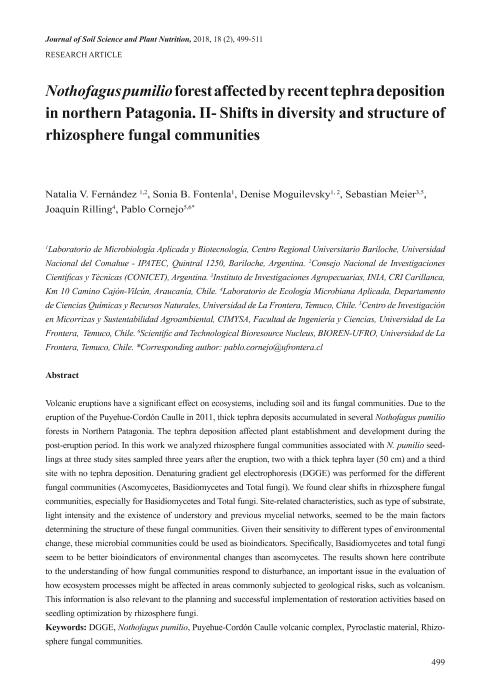Mostrar el registro sencillo del ítem
dc.contributor.author
Fernández, Natalia V.
dc.contributor.author
Fontenla, Sonia

dc.contributor.author
Moguilevsky, Denise

dc.contributor.author
Meie, Sebastián
dc.contributor.author
Rilling, Joaquín
dc.contributor.author
Cornejo, Pablo Sebastian

dc.date.available
2019-12-05T19:32:27Z
dc.date.issued
2018-06
dc.identifier.citation
Fernández, Natalia V.; Fontenla, Sonia; Moguilevsky, Denise; Meie, Sebastián; Rilling, Joaquín; et al.; Nothofagus pumilio forest affected by recent tephra deposition in northern patagonia: II-shifts in diversity and structure of rhizosphere fungal communities; Sociedad Chilena de la Ciencia del Suelo; Journal of Soil Science and Plant Nutrition; 18; 2; 6-2018; 499-511
dc.identifier.issn
0718-9516
dc.identifier.uri
http://hdl.handle.net/11336/91535
dc.description.abstract
Volcanic eruptions have a significant effect on ecosystems, including soil and its fungal communities. Due to the eruption of the Puyehue-Cordón Caulle in 2011, thick tephra deposits accumulated in several Nothofagus pumilio forests in Northern Patagonia. The tephra deposition affected plant establishment and development during the post-eruption period. In this work we analyzed rhizosphere fungal communities associated with N. pumilio seedlings at three study sites sampled three years after the eruption, two with a thick tephra layer (50 cm) and a third site with no tephra deposition. Denaturing gradient gel electrophoresis (DGGE) was performed for the different fungal communities (Ascomycetes, Basidiomycetes and Total fungi). We found clear shifts in rhizosphere fungal communities, especially for Basidiomycetes and Total fungi. Site-related characteristics, such as type of substrate, light intensity and the existence of understory and previous mycelial networks, seemed to be the main factors determining the structure of these fungal communities. Given their sensitivity to different types of environmental change, these microbial communities could be used as bioindicators. Specifically, Basidiomycetes and total fungi seem to be better bioindicators of environmental changes than ascomycetes. The results shown here contribute to the understanding of how fungal communities respond to disturbance, an important issue in the evaluation of how ecosystem processes might be affected in areas commonly subjected to geological risks, such as volcanism. This information is also relevant to the planning and successful implementation of restoration activities based on seedling optimization by rhizosphere fungi.
dc.format
application/pdf
dc.language.iso
eng
dc.publisher
Sociedad Chilena de la Ciencia del Suelo
dc.rights
info:eu-repo/semantics/openAccess
dc.rights.uri
https://creativecommons.org/licenses/by-nc/2.5/ar/
dc.subject
DGGE
dc.subject
NOTHOFAGUS PUMILIO
dc.subject
PUYEHUE-CORDÓN CAULLE VOLCANIC COMPLEX
dc.subject
PYROCLASTIC MATERIAL
dc.subject
RHIZOSPHERE FUNGAL COMMUNITIES
dc.subject.classification
Micología

dc.subject.classification
Ciencias Biológicas

dc.subject.classification
CIENCIAS NATURALES Y EXACTAS

dc.title
Nothofagus pumilio forest affected by recent tephra deposition in northern patagonia: II-shifts in diversity and structure of rhizosphere fungal communities
dc.type
info:eu-repo/semantics/article
dc.type
info:ar-repo/semantics/artículo
dc.type
info:eu-repo/semantics/publishedVersion
dc.date.updated
2019-10-28T19:35:57Z
dc.journal.volume
18
dc.journal.number
2
dc.journal.pagination
499-511
dc.journal.pais
Chile

dc.journal.ciudad
Temuco
dc.description.fil
Fil: Fernández, Natalia V.. Consejo Nacional de Investigaciones Científicas y Técnicas. Centro Científico Tecnológico Conicet - Patagonia Norte. Instituto Andino Patagónico de Tecnologías Biológicas y Geoambientales. Universidad Nacional del Comahue. Instituto Andino Patagónico de Tecnologías Biológicas y Geoambientales.; Argentina; Argentina. Universidad Nacional del Comahue. Centro Regional Universitario Bariloche; Argentina
dc.description.fil
Fil: Fontenla, Sonia. Consejo Nacional de Investigaciones Científicas y Técnicas. Centro Científico Tecnológico Conicet - Patagonia Norte. Instituto Andino Patagónico de Tecnologías Biológicas y Geoambientales. Universidad Nacional del Comahue. Instituto Andino Patagónico de Tecnologías Biológicas y Geoambientales.; Argentina; Argentina
dc.description.fil
Fil: Moguilevsky, Denise. Consejo Nacional de Investigaciones Científicas y Técnicas. Centro Científico Tecnológico Conicet - Patagonia Norte. Instituto Andino Patagónico de Tecnologías Biológicas y Geoambientales. Universidad Nacional del Comahue. Instituto Andino Patagónico de Tecnologías Biológicas y Geoambientales.; Argentina; Argentina. Universidad Nacional del Comahue. Centro Regional Universitario Bariloche; Argentina
dc.description.fil
Fil: Meie, Sebastián. Instituto de Investigaciones Agropecuarias; Chile. Universidad de La Frontera; Chile
dc.description.fil
Fil: Rilling, Joaquín. Universidad de La Frontera; Chile
dc.description.fil
Fil: Cornejo, Pablo Sebastian. Universidad de La Frontera; Chile
dc.journal.title
Journal of Soil Science and Plant Nutrition
dc.relation.alternativeid
info:eu-repo/semantics/altIdentifier/url/https://scielo.conicyt.cl/scielo.php?pid=S0718-95162018005001503&script=sci_arttext&tlng=en
dc.relation.alternativeid
info:eu-repo/semantics/altIdentifier/doi/http://dx.doi.org/10.4067/S0718-95162018005001503
dc.relation.alternativeid
info:eu-repo/semantics/altIdentifier/url/http://jsspn.ufro.cl/index.php?option=com_content&view=frontpage&Itemid=1
Archivos asociados
